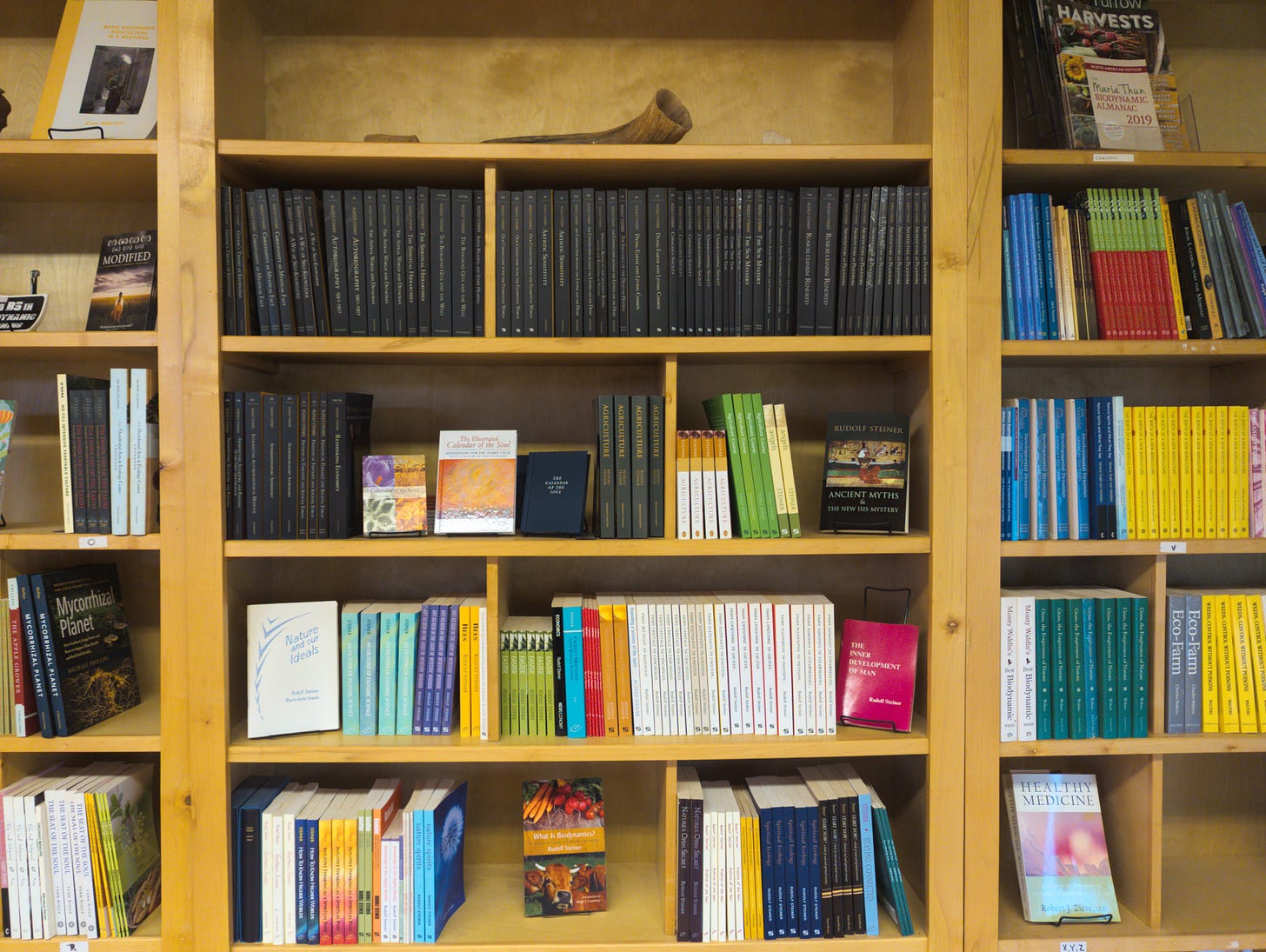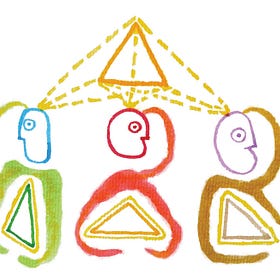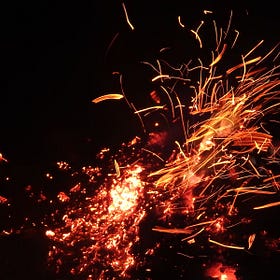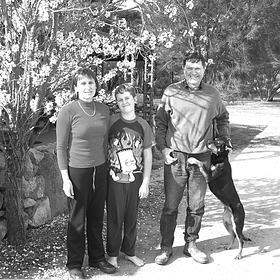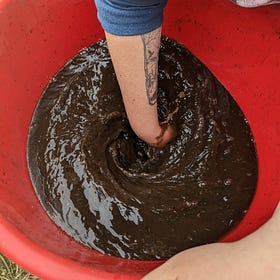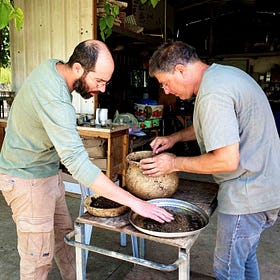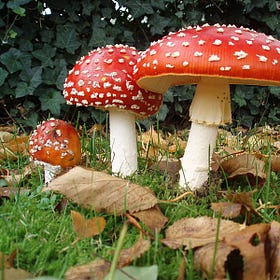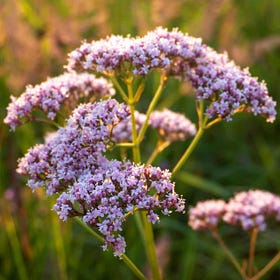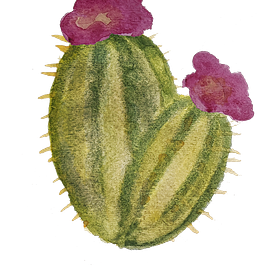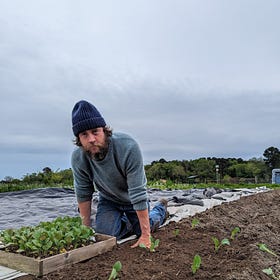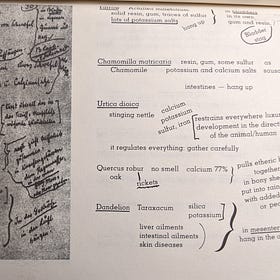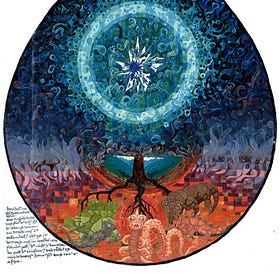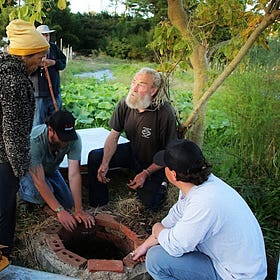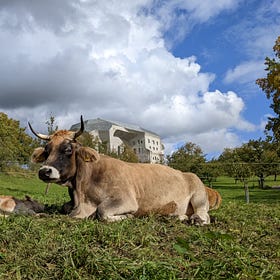Index of Articles
an evolving collection -
Substack isn’t the easiest to navigate, so we’re creating an index of articles here. You can search this page for keywords and (hopefully) find what you’re looking for more easily.
Calendar
To find the current Cosmic Journal for biodynamic planting times, click here.
The Vault
We are gradually migrating some of our best articles from our print Applied Biodynamics. To see articles from our time before being on Substack, click here.
En Español
Many of our articles are being translated into Spanish by our friends. Check it out here.
Articles
How to Save Better Seeds
When you are born, you are a bundle of raw potential; as you mature, your life becomes more lived, and eventually, more of your life has been actualized than remains unperformed. Similarly, art itself feels like being born: a spiritual idea makes contact with the material world but there it must be crafted into being. Birth imparts potential, but life desires to be realized.
Keywords: seeds, seed saving
As Above, So Below
Once upon a time… our solar system did not exist as we know it now. Instead, it was an inconceivably large ball of energy. The hand of the Great Spirit set this ancient prototype of our solar system spinning. As it spun, it slowly condensed. This web of super hot energy gradually contracted into an egg-shaped cloud of glowing gases. If you could have viewed it from deep space, you would have witnessed a shining ovoid.
Keywords: cosmology, esoteric, evolution, cosmos, cosmic
Growing the Sense-Organ of the Farm
Like a human being, in its childhood, a young farm is almost entirely a sense organ. In its infancy, a farm takes rather more than it gives. A preexisting rhythm becomes enclosed within a skin, and the farm organism develops its own pulse, not unlike the way an embryo develops itself as a sheath of pulsing, growing, expanding information. So the farm begins to distinguish what is internal and what is external.
Keywords: cognition, knowing, knowledge, intuition, farming, mathematics, anthroposophy
Introductory Chromatography
In biodynamics, we strive to remain “within the realm of the living” as Rudolf Steiner puts it. This means that for the creation of fertilizers, we focus on things that were quite recently participating in a living organism and try to retain that liveliness so we can impart it into the soil.
Unfortunately, “life” as a quality is invisible: you know it when you see it, but it can’t be quantified. How do we make the subtle qualities of life something we can see with our own eyes?
Keywords: chromatography, Pfeiffer circular chromatography, soil science, qualities, quality, qualitative analysis, introduction
Even Better Compost
Compost is at the heart of fertility in the garden. Debris from the entire farm is brought together and allowed to age, especially ruminant manures. As Rudolf Steiner suggested, the purpose of manuring is to enliven the soil. Similarly, Paracelsian alchemist and father of agricultural chemistry, Wallerius, suggested that the purpose of fertilizing is to “fatten” the soil. To demonstrate the combustible value of various manures, Wallerius undertook the undoubtedly odiferous task of distilling manure from different animals to find that enriching quality that might impart life to the soil.
Keywords: compost, biodynamics, medicinal herbs, soil, kundalini
Harvesting Earth and Sky
“You carry Mother Earth within you. She is not outside of you. Mother Earth is not just your environment. In that insight of inter-being, it is possible to have real communication with the Earth, which is the highest form of prayer.”
Keywords: hierogamy, divine marriage, fertility, soil, divine feminine, cosmos, earth, telluric
Pest and Weed 'Peppers' Revisited
Anything we try to do in biodynamics already exists as a process in Nature. Likewise, anything that is internalized by any organism through the process of evolution already pre-existed as a possibility in the greater world. When we handle pest "peppers,"1 we should consider what macrocosmic process this might replicate from nature. It may be helpful to begin with Rudolf Steiner’s image of a wet winter and a wet spring in the Agriculture Course.
Keywords: pest peppers, weeds, pests, ashing, ash, peppering, eclipses, microcosm, occultation
Old King Farm
Dr. Orest Pelechaty describes himself as neither a Steinarian, nor an anthroposophist, but rather as one who follows a parallel track that uses the best of a number of agricultural principles. He explains also that he is a doctor of Eastern medicine, a practitioner of western herbalism and aromatic medicine, and the proud custodian of a twenty thousand book library pertaining to mystical and occult topics. As a lover of ancient knowledge, he jokingly acknowledges that he still grieves the destruction of the library at Alexandria in Egypt eons ago. Most of the library he now stewards was endowed by Robert Lacy, a scholar who spent 40 years collecting the books. As a hermit for the last 20 years of his life, Lacy focused on alchemical studies, among other topics.
Keywords: profile, farm, farmer, biography
The Embroidery of the Spirit
If we imagine a great circumference of an early stage of our solar system, it might have extended like an enormous egg-like shape, beyond the orbit of any of our current planets–an enormous cloud. This was the original circumference of the Sun. As its threads tightened, it became smaller, and its circumference shrank. Much like a magnifying glass can concentrate light from a wide area to a smaller one, so we can imagine the Sun doing the same, radiating the light of space back to itself. We might imagine that the larger circumference has now condensed into the space of the Sun we see, its surface like a great mirror releasing all the light from a much greater circumference.
Keywords: etheric, astral, weaving, light, space, time, energy, material, matter
Fanning the Flame of Life with Biodynamics
Plants emerge from what once was inside the sun and return the same energy back to the cosmos. Their leaves unfold like etheric flames and culminate in seeds, which fly off like sparks and have the power to spread their green flames out of the hidden life within the soil. If we want our plants to burn brightly, we must nourish that inner fire correctly. Biodynamics offers a way to resurrect dead soil.
Keywords: valerian, valeriana officinalis, 507, oil, sulfur, sulphur, kundalini
The Cashmores
John Cashmore has lived on his farm, Nyonger, a 4800 acre property 40 kilometers east of Hyden, Western Australia, all his life. The farm is roughly five hours drive east of Perth and is only one property away from the edge of farming in Western Australia, the rabbit proof fence. Average annual rainfall is only 325 millimeters or 13 inches. John took over full management of the farm from his father 20 years ago and runs it together with his wife Bernadette and son David.
Keywords: farm, Australia, biography, profile, history
Your Darkness Shall be Turned into Light
In biodynamics, we must begin where the plant begins: with the root. In the development of a plant, the first thing to emerge is its root, followed by its green cotyledons, and finally by its flower with its fruit. In this trichotomy, we see one aspect growing downward and two others growing upward. There is nothing revolutionary about suggesting that the root is light-hating, whereas the green growth and blossom are light-loving. What initially emerges in the plant is its reaching down towards the past, almost as if the root expresses a recollection of its past for the plant. The seed germinates by beginning with the grasping reaching for the past, as an infant reaches for its mother. The seed can be seen as belonging to the continuity of the past into the future, the root aspect reaching the top of the plant. As Steiner says, the “dynamics taken from the soil can be traced as far as the ovary, as far as seed development.” The seed is almost like a pinched-off piece of cambium, able to take root as a new incarnation of the plant, because it maintains an inner kinship to the mother plant’s root, reaching back in time.
Keywords: soil, compost, ahriman, lucifer, mephistopheles, transmutation, christ, regeneration, redemption
From Hand to Heart to Head
“Certain thoughts are practically unthinkable except in terms of an appropriate language and within the framework of an appropriate system of classification. Where these necessary instruments do not exist, the thoughts in question are not expressed and not even conceived.” - Aldous Huxley
Keywords: imagination, cognition, understanding, knowledge, experience, feeling, practice, will, forces, creativity
Human Freedom and the Plant
Biodynamic agriculture strives to hold open spaces for universal human freedom. But to enhance human freedom, we must first ask: what is freedom? In particular, if we start with the plant, what is freedom for a plant?
Keywords: freedom, spiritual, plant, botany, pests, disease, necessity, unfreedom, fungus, mold, mildew, odor, scent
Human Freedom and the Farm Individuality
“Man is free in so far as he is able to obey himself in every moment of his life. A moral deed is my deed only if it can be called a free one in this sense. We have here considered what conditions are required for an intentional action to be felt as a free one; how this purely ethically understood idea of freedom comes to realization in the being of man will be shown in what follows.” - R. Steiner, The Philosophy of Freedom, GA4
Keywords: freedom, spiritual, intuition, cosmic, tzimtzum, kabbalah, ex nihilo, creation, farm organism
Human Freedom and The Artist
“The object isn’t to make art, it’s to be in the wonderful state which makes art inevitable.” - Robert Henri
We’ve done our work for the day and the sun is setting. We’ve eaten our daily bread, but the light is fading. In these late hours, where time becomes untethered from necessity, what does creative freedom look like in that distinctly human way? An animal takes a nap, or a plant dreams. But in these liminal spaces, human beings tell stories, make art, and cultivate community.
Keywords: freedom, creativity, michael, archangel, artistic, feeling, expression, individuality
Interpreting Chromatograms
Most often, when trying to answer questions about something occurring in our plants or soils, we turn to a few methods of approach: observation, empirical science, our past experiences, and personal instinct. Within the biodynamic approach, this equates to listening to our intellect, heart, and gut – a Threefold approach. That’s usually a good foundation to begin figuring out what may be going on with our plants and soils. But inevitably, questions remain while we are deciding how to move forward in each unique circumstance: “is my compost lacking in some necessary nutrients?” “why does this area of the farm grow stunted crops?” “do I make quality biodynamic preparations?”
Keywords: chromatography, Pfeiffer circular chromatography, picture-forming methods, Kolisko, etheric, astral, interpretation
Update: Experimental 500 Horn Manure
You’ll notice a kinship between these two images. They’re clearly “related” but something has changed. If you let your eye settle on one image for several seconds, and then look at the other, you may have the experience of light raying out as you move to the second. If you linger on the image on the right and then move to the image on the left, you might experience a sort of contraction.
Keywords: chromatography, experiment, science, soil analysis, qualitative analysis, horn manure
The Future of Biodynamics
Biodynamic agriculture as we know it is almost 100 years old. The Josephine Porter Institute for Applied Biodynamics (JPI) itself is almost 40. Conceived by Hugh Courtney, the institute’s founder and long-time master preparation maker, JPI began life as an organization in 1985, and its transformation continues to this day. Under Hugh’s guidance, biodynamic agriculture in the United States found a foothold with farmers and gardeners, growing its presence over nearly four decades. The organization's process of rediscovering itself continues in new and exciting ways every year.
Keywords: update, future, biodynamics, centennial, century, retrograde, planets, progress
Gratitude for a Successful Conference
I would like to speak for myself as a farmer and an individual by thanking the Biodynamic Demeter Alliance (BDA) for a successful conference. I want to extend my personal appreciation for the enormous efforts that went into creating an event like this. It is never easy, but there has never been a time so inclined against meeting together.
Keywords: conference, summary, gratitude
Under the Microscope
Ask yourself: is a compost pile alive because it has microbes, OR does a compost pile have microbes because it is alive? In biological farming, one might say that the compost pile is alive because of the abundance of microbial life to be found in it. In biodynamics, the focus is shifted slightly to emphasize that microbes only appear because there is appropriate food — forces — required for their existence.
Keywords: microscopy, microscope, bacteria, microbes, biology, bacteria, forces, preparations
Devotion becomes the Force behind Sacrifice
I remember with great affection the sincere message of Don Miguel De Marchi, when he told us the etymological meaning of the word SACRIFICE, this term, usually is associated with pain and loss. The work that we do at Finca La Esperanza with joy and veneration is far from being a painful burden for us, on the contrary! Having the opportunity every day to encounter the work with the dairy cows, the tending of the animals, and the regeneration of the soil and of the river that borders the farm — all this brings us closer to that inner space in our souls that allows us to make bridge between that which is sacred in our bodies and in the farm organism.
Keywords: sacrifice, devotion, feeling, ideals, artistic expression
Discovering Spiritual Concepts in Nature
“If we want to attain a living understanding of nature, we must become as living and flexible as nature herself." - Goethe
“And thus as we descend the scale of being, Nature speaks to the senses-to known, misunderstood, and unknown senses: so speaks she with herself and to us in a thousand modes. To the attentive observer who is nowhere dead nor silent, she has even a secret agent in inflexible matter, in a metal, the smallest portions of which tell us what is passing in the entire mass."
- Goethe, Theory of Colours, preface
Keywords: feeling, cognition, knowledge, intuition, concepts, nature, meditation, contemplation
When Should I Spray Biodynamic Preparations?
One question I’ve frequently encountered is: when should we spray out the biodynamic preparations? I do not think it is in the spirit of biodynamics or anthroposophy to give a rigid time because the spiritual day is a rhythmic phenomenon. Daylight hours expand during the summer and shrink during the winter, so a precise time is not equally applicable to both winter and summer for spraying.
Keywords: preparations, biodynamics, practical, spraying, horn manure, horn silica, timing, calendar
Biodynamic Tree Paste Recipe
Tree paste is a way to revitalize trees and orchards. It contains clay, the Pfeiffer field spray, the influence of all the biodynamic compost preparations, and fermented Equisetum arvense which helps combat fungus in orchards and vineyards.
Keywords: biodynamic, orchard, vineyard, fungus, mildew, aphids, disease prevention, tree paste
Liron Israely: A Journey to Biodynamics in the Holy Land
A long, circuitous journey brought me to biodynamics and the work of Rudolf Steiner. It really began with my ex-wife. My wife at the time was a second-generation anthroposophist. She is the eldest of four sisters who grew up in Waldorf education.
Keywords: bio, biography, profile, Israel, biodynamics, desert
New Book Release: Biodynamics for Beginners
We are releasing a new title with SteinerBooks, Biodynamics for Beginners: Principles and Practice, in which the “best of” Applied Biodynamics have been collected and edited. Much of Applied Biodynamics has reached an intimate audience, but it is time for the contents to reach the wider world. As a celebration of Applied Biodynamics shifting to the digital realm, we offer a book printed on paper for your library! Below is a preview of the introduction written by Stewart Lundy. 300+ pages of biodynamics!
Keywords: book, press release, introduction, biodynamics, hugh courtney
Under The Influence of Walden: To Build A House
In August of 2023, my wife and I purchased a parcel of land in the eastern highlands of Vermont’s green mountains. For two months, seven days a week, I worked with axes, hand saws, a chisel, and a mallet to build a small timber-framed cabin for our family by hand.
Keywords: biography, story, homestead, DIY, cabin, vermont
How-To: Balancing Biodynamic Soils
“Life is a universal omnipresent principle, and nothing is without life. In some forms life acts slowly—for instance, in stones; in others (organized beings) it acts quickly. Each element has its own peculiar living existences, belonging to it exclusively.”
In my experience, more than a few biodynamic practitioners almost completely ignore the mineral realm. Perhaps this is because they want to take care to “remain within the realms of life” as Steiner urges us. But if we are not conscious about balancing the mineral levels of the soil, we are often missing key elements that need to be present for life to thrive properly. What Steiner means is that we must keep our attention on the unfolding potential dynamics latent within everything. There is potential in compost and all organic matter, but there is also living potential in mineral amendments we might add to our soil.
Keywords: soil balancing, nutrients, NPK, pH, acid, alkaline, remineralization, erosion, soil building, compost
New Interview: Introducing Biodynamics for Beginners
JPI: You're a farmer, an author, an artist and the creative director at JPI. Indeed, you’ve been managing JPI’s presence on Substack since May 2023, plus publishing your own writing elsewhere. Tell us what inspired you to start writing?
Keywords: introduction, book, beginners, hugh courtney, stewart lundy, interview
The Dynamics of Becoming Like a Plant
Do you seek the highest, the greatest?
The plant can be your teacher:
what it is without volition
you can be willfully—that’s it!
Friedrich Schiller
Keywords: spiritual development, soul, spirit, spirituality, plant, initiation
Equisetum and Fungus: Good and Bad
In a prehistoric epoch, the earth was too hot for water to condense into rivers, lakes, or oceans. Instead, other compounds like silicon were fluid. We might say molten but the entire earth did not yet have a solid crust. The earth was once too hot for water to condense into rivers, lakes, or oceans. As Steiner says, “As long as the earth was soft, such forces were still in it.”
Keywords: equisetum, fungus, soil, mushrooms, fungi, mycorrhizae, mycorrhizal, lloyd nelson
Holy Week
“Thou preparest a table before me in the presence of mine enemies: Thou anointest my head with oil.” - Psalm 23:5
During this particular week in the calendar of the soul’s experience of the cosmos, we approach a pivotal moment for biodynamics. This week, we approach the first Sun-day after the first full moon after the vernal equinox. Day and night are in balance; sun and moon are in balance. Now, the year shall unfold.
Keywords: eastertide, holy week, valerian, valeriana officinalis, baldrian, light, sulfur, sulphur, gypsum, mary, lent
The Reality of the Zodiac
On our farm, we raise sheep, hogs, cattle, geese, and a variety of other animals. One thing you’ll notice is that even if you feed the same food to each animal, every animal only becomes itself. Paracelsus calls the inner metabolic wisdom of the living organism the “inner alchemist.”
Keywords: zodiac, reality, animals, livestock, planetary governance, roses, plants, manure
Beyond Biodynamics: Renewing the Doctrine of Signatures
“Anything will give up its secrets if you love it enough. Not only have I found that when I talk to the little flower or to the little peanut they will give up their secrets, but I have found that when I silently commune with people they give up their secrets also – if you love them enough.” - George Washington Carver
Keywords: alchemy, doctrine of signatures, cactus, equisetum, plants, herbalism, sympathetic magic
From Hand to Heart to Head
The most important part of a farm or garden isn’t the soil, the plants, the compost — it’s you. The most important thing to develop isn’t the soil, but the soul of the farmer. But what is a “soul”? The way poets use it, it is not a matter of superstitious belief. It’s a word for our capacity to have a unique private inner life of feelings, thoughts, and wishes. We each have an inner life unlike anyone else’s.
keywords: self-development, spiritual development, practice, experiment, experience, community
Healing Bruised Soil
We have sandy loam at our farm. While this has enormous advantages, whenever there’s heavy rain, the fine particles have a tendency to collapse the topmost layer of soil. Why is this significant?
Collapsed soil—even if sandy—quickly becomes anaerobic (starved of oxygen). When this happens, byproducts of anaerobic sour fermentation arise, which are often toxic to our plants but which pathogenic fungi love. Many germinating weeds especially have an affinity for the sour environment of collapsed anaerobic soil. Soil often tends to “collapse” if left to itself — just as a rock falls if you drop it.
Keywords: soil, compaction, deep ripping, broadfork, loosening, tillage, cultivation, light, zororaster
Adapting Biodynamics Worldwide
Imagining in one language is not the same as imagining in another language. Louis-Marie Chauvet writes, “[T]he ordering of the world varies according to languages and cultures.” When the ideas of biodynamics are “transplanted” from Europe, one cannot expect its expression to remain rigidly the same. The geology, climate and people are all different. A singular spiritual idea takes on the form of the formative forces at work in each bioregion and within each culture. We are not transplanting biodynamics in greenhouses but into real-world conditions. As such, biodynamics must evolve in order to live.
Keywords: adaptation, indigenous, plant medicine, local, regional bioregional, alternatives
Killing More Honeybees
Many of you already know me, but some of you may not. When we moved to our farm in 2010, I had no idea what I was getting into. But without the folly of youth, we wouldn’t start much of anything, would we? If my younger self had known exactly how much work farming would be, he simply would never have begun. I had idealistic notions of working “with” Nature rather than “against” Nature — as if somehow she would spontaneously provide food without effort from me. It turns out that nature is quite happy producing literally anything, and it’s up to me to make sure these are plants that can nourish human beings. It turns out this doesn’t happen without a lot of work.
Keywords: bio, personal, profile, perennial roots farm, stewart lundy, soil, honeybees
Gaia Workshop Summary & Photos
Driving from coastal Virginia to North Carolina, the terrain changed from flatland to rolling green hills. At Gaia Herbs Farm, we walked through well-established ginkgo trees led by JPI board member Will Bratton (Biodynamic Guild Podcast). The clouds are so dramatically different in the mountains compared to my own farm on the eastern shore of Virginia.
Keywords: lloyd nelson, gary caton, stewart lundy, valerian, 507, valeriana officinalis
Upside Down Biodynamics
In his medical lectures, Steiner describes the gut as a “root” and the head as a “flower,” which is the exact opposite of what is offered in the Agriculture Course. Lloyd Nelson described how Anthroposophical physicians are sometimes confounded by this apparent contradiction. This is even more of a paradox when we recall that Rudolf Steiner asked Dr. Ita Wegman to include biodynamic agriculture under the Medical Section at the Goetheanum. Steiner had the idea that physicians should work directly with farms. Rather than relying on vivisection, on a farm doctors can actually immerse inside a living organism and feel what a healthy (or unhealthy) organism is like from inside it. The partnership between farmers and physicians is one that should be cultivated.
Keywords: biodynamics, inversion, alchemy, alchemical reversal, kundalini
Leveling Up Your Biodynamic Gardening
Biodynamic practices work in concert with a wide array of regenerative and organic gardening and farming methods. In biodynamics, we do not dictate any particular approach to tending a garden. So long as it works for you and is a way of regenerating the soil more than it is depleted, it is likely a method that is compatible with biodynamics. Some of you may not know where to begin, though, so you might consider the work of John Jeavons and the Grow Bio-Intensive approach, which boasts of supplying a complete diet year-round from as little as 1000 sq ft.
Keywords: improvement, tips, DIY, sprays, biodynamic, advanced
Devoted to Healing Our Earth
It’s an honor to report the fruits of a successful annual workshop making the preparations at the JPI farm. We had a lovely range of people visiting us from as far as Michigan, South Carolina, and beyond. Some of us were gardeners, others herbalists, naturopaths in training, as well as farmers. All were supportive souls.
Keywords: workshop, summary, community, preparations, biodynamic
The Rites of Pan and the Garden
I am almost reluctant to write about the faerie realm. But only almost. The thing is, when one speaks of the denizens of the Otherworld, one invites mischief. One time, for instance, when I was in a conversation with someone (I forget who) about faeries, my keys went mysteriously missing. I found them a day later in my dog’s cage. Another time, my Regeneration Podcast partner, Mike Sauter, and I were interviewing Irish artist and writer James Tunney about The Secret Commonwealth—and they kicked me off of the internet for twenty minutes right in the middle of the conversation! James later told me that they also caused his bathtub to overflow that same day. But I’m not so reluctant as to avoid it. It’s worth the risk.
Keywords: elemental beings, fairies, fay, nature spirits
Dead Warmth & Living Warmth (Part 1 of 5)
Have you ever been outside when it’s cold and then opened the door to a warm house? A torrent of warm, turbulent air rushes out, and another current of cold air moves inside. Our family perhaps yells at us to close the door as we stomp off the snow on our boots. When the door closes, the exchange of hot and cold becomes restricted.
Keywords: warmth, life, living warmth, coldth, spirit, soul, astral
Dead Warmth & Living Warmth (part 2 of 5)
Living warmth always shows up precisely where you wouldn’t expect it. Aldous Huxley says, “Consistency is contrary to nature, contrary to life. The only completely consistent people are the dead.” Any living thing — including a movement — that becomes entirely uniform is like a plant entombed in amber — something that cannot change is a corpse. Mineral warmth consistently wishes to rise, though this gives even “mineral” warmth — warmth in a physical sense not being directed within a living organism — a certain kind of liveliness, for nothing, is completely dead. But there is another kind of warmth, a warmth within liveliness — distinguished from the mild liveliness of external warmth accumulated in rocks. Warmth within a living organism moves in astonishingly inconsistent ways.
Keywords: soul, soil, warmth, emotions, feelings, plants
Dead Warmth & Living Warmth (part 3 of 5)
In gardening, we are always balancing warmth and coldth, dryness and wetness. This is so ordinary that we forget how miraculous it is. We can take what would go downhill and bring it up to the top of a mountain, and we can take organic materials that would just disintegrate in the sun and turn them into compost, giving to the soil far more than it would normally receive left to itself.
We irrigate, cultivate, and tend the soil. Yes, plants need water and fertilizing compost for growth, but they also require warmth, air, and light to sweeten into nutritive foods for us. Too much of the dark, heavy elements causes a plant to fail to produce sweet fruits, but too much warmth and light causes the plant to simply perish.
Keywords: soil, plants, light, saturn, planets, warmth, air, light, elements
You Can't Take the Sky From Me
As the philosopher Hans-Georg Gadamer writes, “There are intuitive anticipations of knowledge, like the knowledge of the salvation of the homo religiosus, which often has something to say to the doctor, or the ‘knowledge’ of the poet, which is able to outdistance that of the psychologist, sociologist, historian and philosopher.”
Keywords: causality, proof, scientific, science, studies, experiments
Inside Out Biodynamics
Developing a newly received idea is a bit like trying to create a stabilized new variety of tomato. Your initial cross with some other heirloom variety makes a first-generation cross (“F1”), which may have some wild variations from plant to plant. But if you carefully save seeds from those that remain “true to type” and plant them again, you get the next generation F2, which still has some surprising variations. But as you proceed to F3, F4, F5, etc., you eventually get to a stabilized variety that produces a particular kind of new tomato consistently. In the world of ideas, we must likewise “interrogate every spirit” and let them grow repeatedly within us. If our idea is a strange hybrid between incompatible species, it will soon prove itself: the idea will stop being able to reproduce, or it will regress back into some wild, thorny thing.
Keywords: sausage, chamomile, 503, preparations, notes, history, research
The Human Being as a Preparation for a Sick Society
In this contentious political season, it can be difficult to see the point of biodynamic agriculture when our society is dominated by shallow, materialistic thinking. When a materialist looks for a solution, they seek a cure by blaming the symptoms rather than asking, “Why?” repeatedly and addressing the root cause. The last thing that happened is not the first cause but the final result of long chains of misguided action. Rudolf Steiner himself criticized the “centralized” attitude — as in Moscow Center — that overran his Anthroposophical Society. “[W]e should avoid the mistakes which only became evident during the years when from the central anthroposophical work—if I may so describe it—we went on to other work which lay more at the periphery.”
Keywords: individuality, spiritual life, growth, compost, society, social
Everything is Emblematic
“It is not words only that are emblematic; it is things which are emblematic. Every natural fact is a symbol of some spiritual fact. Every appearance in nature corresponds to some state of the mind, and that state of the mind can only be described by presenting that natural appearance as its picture.”
Keywords: emblematic, sigilistic, symbolism, microcosmic, microcosmic, imago dei
On Building the Alchemical Vessel
We get inspiration from philosophies and practices of deep agriculture that seek to penetrate in the mysteries of life and at the same time regenerate and vitalize soils and ecosystems, a big influence on the work we do is the biodynamic agriculture propose by Rudolf Steiner, which places the farmer as a mediator of the process and forces of heaven and earth.
Keywords: Mexico, jungian, psychology, soul, spirit, experience, alchemy
Hugh Courtney & DIY Quality Testing Biodynamic Preparations
The aim with biodynamic preparations is humus that has become so uniform that the original parent material is almost entirely invisible. When humus is well formed, it develops a claylike (“colloidal”) quality. You can take such humus, mold it into shapes, and reform it back into a ball. It has a liveliness to it that isn’t like dusty organic matter or wood chips — it is more attracted to itself than to the surrounding world. You’ll see such beautiful humus fill your fingerprints. This is what we aim for with biodynamic preparations.
Keywords: quality assurance, qualitative analysis, hugh courtney, preparations, horn manure, 500
Biodynamic Preparations as Esoteric Fruits
Everything on Earth is made possible by the constant influx of energy from the cosmos. When we fertilize our fields with compost, we bring living potential energy to the soil so that it can be discharged as kinetic energy in the growth forms of plants. But not all energy is the same. The heat of a gas stove is not the same as the warmth of a mother hen incubating her egg. Likewise, not all compost is created equal. The resulting organic matter from the process of decomposition still bears many inner similarities to the parent materials from which it formed.
Keywords: fruit, preparations, ripening, compost, medicines, medicinal herbs, herbalism
Foundations of The Pfeiffer Recipe
Developed during a time of utmost secrecy around the biodynamic preparations, Dr. Ehrenfried Pfeiffer cultivated what I describe as a carefully crafted “smoke screen” to reinforce the protection of the biodynamic preparations themselves. He took microbiological samples from biodynamic preparations, soils, and excrement. He maintained and cryptically labeled these isolated microbes, but as Pfeiffer himself says, these microbes were never the essence of the Field and Garden Spray. The real activities of the Field Spray are driven by the biodynamic preparations, which are no secret anymore. But many have asked: what is the Pfeiffer Field and Garden Spray?
Keywords: Pfeiffer, field and garden spray, compost starter, biodynamic preprations, archive, vault, secrets, recipe
Cosmic Forces & Earthly Substance
“The flower exists for its own sake,—not for the fruit’s sake. The production of the fruit is an added honour to it—is a granted consolation to us for its death. But the flower is the end of the seed,—not the seed of the flower.” - John Ruskin, Proserpina
Keywords: microcosmic, macrocosmic, planetary, planets, fruit, ripening, forces
Towards a New Herbalism
“We find our own goals in Nature, which must thus be correctly read. But since our spiral path has taken us away from the immediate unity with nature, we can no longer read it easily. What Romantic art, Poetry, strives to do is recover an adequate reading, and this would of necessity mean the creation of a mode of symbolic access.”
Keywords: herbalism, health, homeopathy, paracelsus, alchemy, doctrine of signatures
In Search of Vitality
Mirrors of the Holobiont seeks to establish a relationship and dialogue between iridology and soil chromatography, two systematic study methods used for the diagnosis of the state of health of two diverse, but interrelated living bodies: the human body and the Earth.
Keywords: art, iris, iridology, pfeiffer circular chromatography
Update: Fall Biodynamic Workshop 2024
There are many reasons to participate in a biodynamic workshop. Perhaps you’re a farmer, and you want to revitalize your land. Or maybe you’re a gardener who wants to participate in making remedies that help heal the earth. Or perhaps your motive force is the wellsprings of anthroposophy. Or maybe you don’t garden at all, but you intuit that biodynamics is a meaningful way to work with other people to make the world a bit better. After all, regardless of where we live and work, none of us are “separate” from Nature by the very fact that we live and move and eat from the same Earth. As a fish cannot live out of water, we cannot live outside the Earth — but like fish belong to the ocean and are a part of it, we too are part of the Earth.
Keywords: workshop, community, biodynamic preparations, summary, report
Visiting the Goetheanum
“If you want nature to treat you well, you must treat nature well. If you start destroying nature, nature will destroy you, and this basic moral precept is fundamental in our present knowledge of ecology and conservation. What we know now about ecology points to the fact that nature exists in the most delicate balance, and that anything which tends to upset the balance will produce consequences of the most unexpected character and often of the most disastrous character.” - Aldous Huxley
Keywords: dornach, goetheanum, science, travel, biodynamics
Intuiting Wholeness
Imagine a great pile of millions of dots, but forget it is a pile. See instead only countless points. The modern way of “knowing” tends to aggregate disparate points, like stippling in art. Or a great pile of crystalline snowflakes.
Keywords: wholeness, monad, cognition, intuition
Sunrise to Eternity
It is not enough to believe in the past. The future must always be born in us anew, day by day. As Rudolf Steiner suggests in Love and Its Meaning in the World, love is always “love of the not-yet.” If we only appreciate who someone (or something) was in the past, we have blocked ourselves from the future. But because I expect myself to be considered more than merely the sum of my past deeds, but also my future possibilities, I also find I must extend this charitable gaze to other people, other movements, and even institutions. The whole is always greater than the sum of its parts, as Aristotle says, and the past is only one part of us. To love people is to love who they are not yet — to love who they are becoming.
Keywords: becoming, evolution, biodynamics, future, growth, love
Giving Gifts to the Elemental World
With the arrival of advent in the northern hemisphere, we focus strongly inward. Leaves fall, their vitality drained. They leave behind colorful signatures of their mineral composition. The sun continues to rise a little lower every day, appearing as if it might slip away forever.
Keywords: 3K, three kings, epiphany, theophany, christ, gold, frankincense, myrrh, january, elemental beings, nature spirits
Healing Wounded Trees
By our house is a tall loblolly pine (Pinus taeda) that my wife and her father planted many years ago. It stands tall, shedding pine needles (and ubiquitous pollen) during varying seasons. There is such a stark difference in the growth of a pine tree versus, say, an oak. Not only are the leaves so incredibly different, but the trees behave in such radically distinct ways. An oak tree, in Ehrenfried Pfeiffer’s words, is one of the only trees that
Keywords: tree paste, resin, sap, experiment, saturn
The Dynamics of Creation in Mexico
It had been a long time coming. Jose, Alejo, and I have been talking for years, and we’ve been nurturing the idea of a new intensive retreat in Mexico. As with anything that is born, there is a prolonged gestation period before the newborn impulse arrives. We want to express our special thanks to Ricardo, who hosted us at his ranch, and to his team for managing hospitality and attentively filming the entire event (thank you, Maria and Aguirre!).
Keywords: travel, Mexico, biodynamic, workshop, conference, photos
2024: A Big Year in Review
2024 was a busy year full of travel, preparation-making, writing, and teaching. I’ve never been so busy with this biodynamic work.
Keywords: review, summary, reflection, travel, photos
Just a Drop: Chromatography and the Tiniest Entities
For this experiment, we selected a sample of soil from a garden bed that had not been tilled recently and only took the sample from the uppermost topsoil. The soil on our farm is a Bojack Sandy Loam, which drains well, to the point of becoming too dry. In terms of agricultural use, though, given the annual rainfall in Virginia — often over 40 inches — it is generally better that the soil dries too quickly than too slowly. That said, we have been in the midst of a significant drought, and the pasture is suffering. Many soils need to be lightened by cultivation.
Keywords: biodynamics, homeopathy, chromatography
Standing on Common Ground
“Whoever is incapable of treating every foreign thought as though it were his own, and a personal thought as though it were foreign—is no true scholar.” - Novalis
Keywords: utah, travel, lloyd nelson, stewart lundy, photos, zion, photosK
Contemplative Chromatography
Picture-forming methods are not just for analysis, but contain within the practice an approach to developing dormant capacities of the entire human being. You could almost say that through the disciplined use of picture-forming methods from soil we develop the inner picture-forming powers of the soul. Picture-forming methods are not about mere fanciful daydreaming but instead, a kind of exact imagination that becomes, with enough practice, as objective as our senses.
Keywords: chromatography, soil, contemplation, meditation, spiritual science




